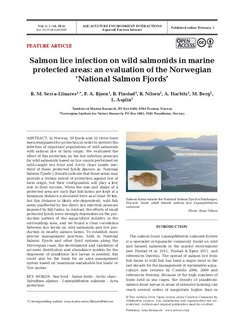| dc.contributor.author | Serra-Llinares, Rosa Maria | |
| dc.contributor.author | Bjørn, Pål Arne | |
| dc.contributor.author | Finstad, Bengt | |
| dc.contributor.author | Nilsen, Rune | |
| dc.contributor.author | Harbitz, Alf | |
| dc.contributor.author | Berg, Marius | |
| dc.contributor.author | Asplin, Lars | |
| dc.date.accessioned | 2014-02-11T12:10:23Z | |
| dc.date.available | 2014-02-11T12:10:23Z | |
| dc.date.issued | 2014-02-05 | |
| dc.identifier.citation | Serra-Llinares RM, Bjørn PA, Finstad B, Nilsen R, Harbitz A, Berg M, Asplin L (2014) Salmon lice infection on wild salmonids in marine protected areas: an evaluation of the Norwegian ‘National Salmon Fjords’. Aquacult Environ Interact 5:1-16 | no_NO |
| dc.identifier.issn | 1869-7534 | |
| dc.identifier.uri | http://hdl.handle.net/11250/109333 | |
| dc.description.abstract | In Norway, 29 fjords and 52 rivers have been designated for protection in order to prevent the infection of important populations of wild salmonids with salmon lice of farm origin. We evaluated the effect of this protection on the lice infection pressure for wild salmonids based on lice counts performed on wild-caught sea trout and Arctic charr inside one-third of these protected fjords (known as ‘National Salmon Fjords’). Results indicate that these areas may provide a certain extent of protection against lice of farm origin, but their configuration will play a key role in their success. When the size and shape of a protected area are such that fish farms are kept at a minimum distance (calculated here as at least 30 km, but this distance is likely site-dependent), wild fish seem unaffected by the direct lice infection pressure imposed by fish farms. In contrast, the effects of small protected fjords were strongly dependent on the production pattern of the aquaculture industry in the surrounding area, and we found a clear correlation between lice levels on wild salmonids and lice production in nearby salmon farms. To establish more precise management practices, both in National Salmon Fjords and other fjord systems along the Norwegian coast, the development and validation of accurate distribution and abundance models for the dispersion of planktonic lice larvae is needed; this could also be the basis for an area management system based on ‘maximum sustainable lice loads’ or ‘lice quotas.’ | no_NO |
| dc.language.iso | eng | no_NO |
| dc.publisher | Inter-Research | no_NO |
| dc.title | Salmon lice infection on wild salmonids in marine protected areas: an evaluation of the Norwegian ‘National Salmon Fjords | no_NO |
| dc.type | Journal article | no_NO |
| dc.type | Peer reviewed | no_NO |
| dc.subject.nsi | VDP::Agriculture and fishery disciplines: 900::Fisheries science: 920::Fish health: 923 | no_NO |
| dc.source.pagenumber | 1-16 | no_NO |
| dc.source.volume | 5 | no_NO |
| dc.source.journal | Aquaculture Environment Interactions | no_NO |
| dc.source.issue | 1 | no_NO |
| dc.identifier.doi | 10.3354/aei00090 | |
